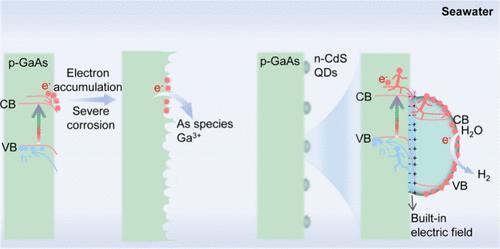异质结工程显著抗海水和光腐蚀,使光电化学探测器寿命延长
IF 9.1
1区 材料科学
Q1 CHEMISTRY, MULTIDISCIPLINARY
引用次数: 0
摘要
光通信技术被认为是海洋勘探开发的关键技术之一,而光电探测器是实现光通信技术的关键。然而,复杂的海洋环境(如光衰减和海水腐蚀性)阻碍了传统光电探测器的应用。在这里,我们报道了一种具有灵敏度,稳定性和海水下宽带响应的p-GaAs/n-CdS光电电化学光电探测器。强大的内建电场驱动电子输运加速的异质结协同作用、阶梯式能带结构和n-CdS的高电子迁移率赋予了快速的界面反应,避免了GaAs上电子积累引起的光腐蚀。得益于上述优点,p-GaAs/n-CdS在0 V宽带范围内的光探测性能比p-GaAs明显增强,响应时间短,为2.16/2.22 ms,探测率高,为1.06 × 1010 Jones,响应速度快,为17.3 mA W-1,在海水下的稳定寿命延长了10倍以上(从150秒到1600秒)。本文章由计算机程序翻译,如有差异,请以英文原文为准。

Heterojunction Engineering Significantly Resisting Seawater and Photocorrosion Enable Photoelectrochemical Detectors’ Prolonged Lifespan
Optical communication technology is regarded as one of the most critical technologies for marine exploration and development, and the photodetector is the key to its realization. However, the complex marine environment (such as light attenuation and seawater corrosivity) hinders the applications of conventional photodetectors. Here, we report a p-GaAs/n-CdS photoelectrochemical photodetector with sensitivity, stability, and broadband response under seawater. The heterojunction synergy of electron-transport acceleration driven by the strong built-in electric field, a stepped energy band structure, and high electron mobility of n-CdS endows the rapid interfacial reaction and avoids photocorrosion caused by electron accumulation on GaAs. Benefiting from the aforementioned advantages, p-GaAs/n-CdS exhibits a markedly enhanced photodetection performance under the broadband range at 0 V compared with p-GaAs, which delivers short response times of 2.16/2.22 ms, a high detectivity of 1.06 × 1010 Jones, a fast responsivity of 17.3 mA W–1, and an especially stable life prolonged by more than 10 times (from 150 to 1600 s) under seawater.
求助全文
通过发布文献求助,成功后即可免费获取论文全文。
去求助
来源期刊

Nano Letters
工程技术-材料科学:综合
CiteScore
16.80
自引率
2.80%
发文量
1182
审稿时长
1.4 months
期刊介绍:
Nano Letters serves as a dynamic platform for promptly disseminating original results in fundamental, applied, and emerging research across all facets of nanoscience and nanotechnology. A pivotal criterion for inclusion within Nano Letters is the convergence of at least two different areas or disciplines, ensuring a rich interdisciplinary scope. The journal is dedicated to fostering exploration in diverse areas, including:
- Experimental and theoretical findings on physical, chemical, and biological phenomena at the nanoscale
- Synthesis, characterization, and processing of organic, inorganic, polymer, and hybrid nanomaterials through physical, chemical, and biological methodologies
- Modeling and simulation of synthetic, assembly, and interaction processes
- Realization of integrated nanostructures and nano-engineered devices exhibiting advanced performance
- Applications of nanoscale materials in living and environmental systems
Nano Letters is committed to advancing and showcasing groundbreaking research that intersects various domains, fostering innovation and collaboration in the ever-evolving field of nanoscience and nanotechnology.
 求助内容:
求助内容: 应助结果提醒方式:
应助结果提醒方式:


